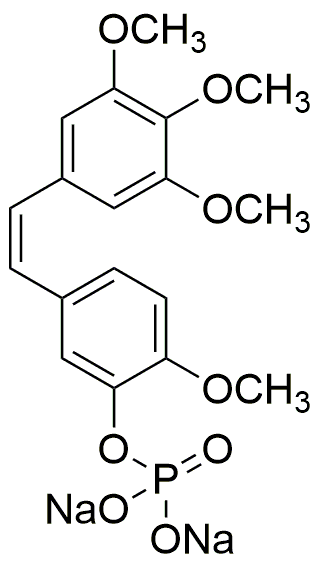Combretastatin A4 phosphate disodium salt is widely utilized in research focused on:
- Cancer Treatment: This compound is being studied for its ability to inhibit tumor growth by disrupting the blood supply to tumors, making it a promising candidate for cancer therapies.
- Drug Development: Researchers are exploring its potential as a lead compound in the development of new anti-cancer drugs, particularly due to its unique mechanism of action compared to traditional chemotherapy agents.
- Targeted Therapy: Its specificity for tumor vasculature allows for targeted treatment options, reducing side effects commonly associated with non-targeted therapies.
- Combination Therapy: It is being evaluated in combination with other chemotherapeutic agents to enhance efficacy and overcome drug resistance in various cancer types.
- Preclinical Studies: The compound is frequently used in preclinical models to assess its pharmacokinetics and pharmacodynamics, providing valuable insights for future clinical trials.
Informations générales
Propriétés
Sécurité et réglementation
Applications
Combretastatin A4 phosphate disodium salt is widely utilized in research focused on:
- Cancer Treatment: This compound is being studied for its ability to inhibit tumor growth by disrupting the blood supply to tumors, making it a promising candidate for cancer therapies.
- Drug Development: Researchers are exploring its potential as a lead compound in the development of new anti-cancer drugs, particularly due to its unique mechanism of action compared to traditional chemotherapy agents.
- Targeted Therapy: Its specificity for tumor vasculature allows for targeted treatment options, reducing side effects commonly associated with non-targeted therapies.
- Combination Therapy: It is being evaluated in combination with other chemotherapeutic agents to enhance efficacy and overcome drug resistance in various cancer types.
- Preclinical Studies: The compound is frequently used in preclinical models to assess its pharmacokinetics and pharmacodynamics, providing valuable insights for future clinical trials.
Documents
Fiches de données de sécurité (FDS)
La FDS fournit des informations de sécurité complètes sur la manipulation, le stockage et l’élimination du produit.
Spécifications du produit (PS)
Le PS fournit une description complète des propriétés du produit, notamment sa composition chimique, son état physique, sa pureté et les exigences de stockage. Il détaille également les plages de qualité acceptables et les applications prévues du produit.
Certificats d'analyse (COA)
Recherchez des certificats d'analyse (COA) en saisissant le numéro de lot du produit. Les numéros de lot et de lot se trouvent sur l'étiquette d'un produit, après les mots « Lot » ou « Lot de fabrication ».
Numéro de catalogue
Numéro de lot/série
Certificats d'origine (COO)
Ce certificat d'exploitation confirme le pays dans lequel le produit a été fabriqué, et détaille également les matériaux et composants utilisés et s'il est issu de sources naturelles, synthétiques ou autres sources spécifiques. Ce certificat peut être requis pour les douanes, le commerce et la conformité réglementaire.
Numéro de catalogue
Numéro de lot/série
Fiches de données de sécurité (FDS)
La FDS fournit des informations de sécurité complètes sur la manipulation, le stockage et l’élimination du produit.
DownloadSpécifications du produit (PS)
Le PS fournit une description complète des propriétés du produit, notamment sa composition chimique, son état physique, sa pureté et les exigences de stockage. Il détaille également les plages de qualité acceptables et les applications prévues du produit.
DownloadCertificats d'analyse (COA)
Recherchez des certificats d'analyse (COA) en saisissant le numéro de lot du produit. Les numéros de lot et de lot se trouvent sur l'étiquette d'un produit, après les mots « Lot » ou « Lot de fabrication ».
Numéro de catalogue
Numéro de lot/série
Certificats d'origine (COO)
Ce certificat d'exploitation confirme le pays dans lequel le produit a été fabriqué, et détaille également les matériaux et composants utilisés et s'il est issu de sources naturelles, synthétiques ou autres sources spécifiques. Ce certificat peut être requis pour les douanes, le commerce et la conformité réglementaire.


